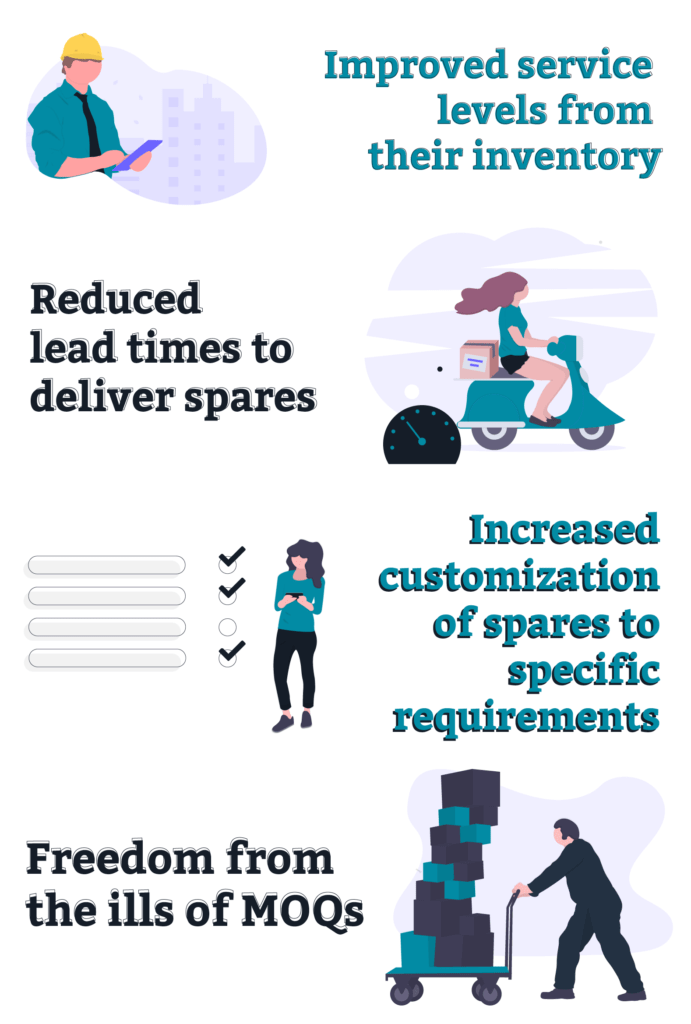With digital transformation affecting every part of the supply chain, old problems are using (adopting) new solutions. Spare parts management is a perennial issue in so many sectors, requiring a fine balance between service levels and working capital. However, digital innovations are changing the dynamic, bringing capabilities that were previously unreachable and re-writing the rules of the past. In this article, you will witness this change through the experience of one of the largest rail companies in the world, learning lessons that can be readily applied to your spare parts management.
In 2015, the German rail company Deutsche Bahn (DB) faced a problem that many in the heavy engineering sectors will recognise:


With a wide variety of assets, some of which were decades old, the previous efforts that they had adopted to ensure that the right spare was always available consisted of employing enhanced maintenance routines, of using sensors to detect issues and, ultimately, to hold a monumental number of spares: at its peak, DB has 120,000 SKUs to manage, with a typical value of €600 million each year held in several warehouses internationally. As supply chain managers will know all too well, though, even with these actions in place, there remain several issues to deal with:
- Suppliers of many older parts no longer made those items, and many had gone out of business altogether
- Procurement was forced to order far more spares than they needed as suppliers imposed minimum order quantities (MOQs) to justify their efforts to retool and manufacture older parts
- The design data for the majority of parts – where (when) it was available – was archaic, existing on paper or in obsolete digital formats
The pain that this resulted in hit the most visible metrics:


as assets were rendered unproductive because of the lack of spares, with operations suspended and units side-lined while technicians waited for parts with long lead times


as the costs of procuring, holding and disposing of spares were far higher than they needed to be


as so many obsolete parts had to be disposed of every year
In sectors such as oil & gas, mining, shipping, defence, aerospace and, of course, others in the rail sectors, those can quickly represent millions of dollars. Like decision makers in those sectors, DB had to find a better way of doing things.
One approach which has quickly borne fruit was to use 3D printing. Increasingly, companies are looking to this family of technologies as a way of solving issues with making parts for end use. While for much of its 35-year history 3D printing has been extensively used as a tool to help with design and prototyping, advances in the 3D printing techniques, materials science and the design tools used over the last 10 years are transforming its capabilities and, from that, demand for it. Recent innovations, particularly the drive towards digital transformation, as well as the shifting dynamics that supply chains face are further catalysing this trend. The market for 3D printing has been growing at 25% year-on-year for much of the last decade and today 48% of manufacturing companies are employing it for production in most sectors that involve engineering and manufacture. By doing so, companies are reaping benefits such as:


Moreover, the flexibility of 3D printing means that they can produce lighter parts, with fewer components that need to be assembled, or parts with optimized geometries that suit the specific dimensions that they need. It is those benefits are driving 3D printing’s place in the manufacturing toolkit.
Initially, DB attempted a systematic approach, mapping the family of SKUs, analysing the data they had on each item from their procurement, engineering, logistics and other support systems to identify those spares which it made the most sense to 3D print. However, they found that, despite there being plenty of data, its quality and completeness made the task too complex. A different methodology was needed. Instead, the team at DB which led the 3D printing efforts travelled to key workshops, briefed the staff there on what 3D printing is and what it can do, and asked for recommendations on what to use it for. That initiative quickly resulted in a list of items, from small plastic grommets to large metal boxes, which suffered from long lead times, expensive procurement or unrealistic MOQs.
Now they faced the question of how to go about implementing 3D printing. As with any modern manufacturing technology, 3D printers are not cheap. Different machines are needed for each material type, for each 3D printing technology. Moreover, the items that were needed had to be designed for 3D printing or reverse-engineered from existing designs. All of those required skills and funding that weren’t achievable.
The solution that DB employed was to use external specialists. They hired a company with dedicated design specialists to produce the data files that were needed, using a mix of scanning and digital design skills. Those were passed to one of several firms which leased their 3D printing capacity, choosing the right machine, with the right capabilities for the job, having quality assured its output. By using this approach of outsourcing their 3D printing needs and employing a rudimentary manufacturing-as-a-service (MaaS) model, DB kept costs down while very quickly reaping the benefits of using 3D printing. Lead times for items were reduced from months to a few weeks, from several weeks to days. Repair times were significantly reduced: in one case, a spring mechanism – previously the lowest replaceable part – was repairable by changing a small plastic sleeve, reducing the time to complete the job from eight hours to one, and all for a few hundred Euros. Those quickly translated in higher service levels from inventory and higher availability of DB’s main assets. Moreover, when the end-to-end costs of each item were considered – including procurement, manufacturing, logistics and ancillary costs – there was a very clear financial incentive to use 3D printing, with savings of several thousand Euros per item.
These 3D printing and MaaS capabilities are increasingly available to supply chain managers globally. Companies like DiManEx, Ivaldi and Sculpeo offer companies full end-to-end services, from design (or reverse engineering) to 3D printed manufacture, employing networks of approved 3D printing entities to produce items with the right quality and ship them to end-users. Moreover, the companies that make 3D printers such as Stratasys and Voxeljet are also providing 3D printing services, producing items on demand using their families of machines. These full- and part-service models significantly reduce the costs of accessing 3D printing capabilities while reaping the benefits in time and cost savings that the technologies promise.
The positive technical aspects of employing 3D printing, while sitting at its heart, are but one element in the supply chain transformation that 3D printing involves. There are still several issues, such as quality control and assurance, regulation and certification, IP protection and liability, that must be considered if adopting 3D printing methodologies. Moreover, as when employing other major new technologies, there is a high degree of change management that must also be implemented from the outset if 3D printing initiatives are to succeed. Get them right, and further benefits of 3D printing will arise. For instance, DB found that they could use stronger materials when making some metal objects which had the benefit of extending their useful life. In another example, they were able to provide their internal customers – in this case, stationmasters – with bespoke parts that would not have been financially viable using other manufacturing techniques, such as Braille signs for use in stations.
With 3D printing technologies continually evolving, and improving the accuracy and precisions of items that they produce, and integrating post-production techniques to make items that are ready for end-users, supply chain managers should now be considering how those technologies can be used as a solution to the challenges of their spare parts, improving service levels and reducing the costs of inventory. The opportunity is only growing: a study by ING Bank has identified that, at the current rate of investment and development, 50% of manufacturing will be conducted by 3D printing over the next 20-30 years, the typical lifespan of assets in those heavy engineering sectors. That includes items in the entire product value chain: prototypes, tools for manufacture and items for end use. Like DB, companies such as Whirlpool and Daimler Benz, and organisations such as the US Marine Corps and the Dutch Army, are already using 3D printing to support their spare parts management, increasing service levels – and thence revenues – while reducing costs. Others are sure to do likewise, gaining a competitive advantage for their supply chains.
Visagio is a global management engineering company with a strong analytical and technical background, with a focus on implementation. Our extensive experience in the fields of Supply Chain, Finance, and People and Performance enables us to support our clients through the realisation of consulting projects or by fully managing their operations on an interim basis. We combine our management expertise in the areas of Technology and Analytics to operationalise our clients’ strategies and processes, solving their challenges on the road to digital transformation.
About the author
Len Pannett is our Managing Partner based in London, UK, and has over 25 years’ experience of helping engineering, manufacture and technology organisations to implement operational transformations. The President of the UK Roundtable of the Council of Supply Chain Management Professionals (CSCMP) and a Fellow of the Institution of Engineering and Technology (IET), he is an award-winning speaker and author on the impact of 3D printing on supply chains.


